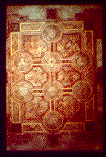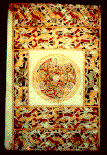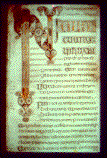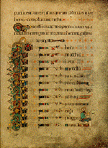Manuscripts, Books, and Maps: The Printing Press and a Changing World
Four Important Periods in the History of the Book
- I. 7th to 13th Century: The age of religious "manuscript" book
production. Books in this period are entirely constructed by hand, and
are largely religious texts whose creation is meant as an act of
worship.
- II. 13th to 15th Century: The secularization of book production. Books
are beginning to be produced that do not serve as objects of worship,
but that try to explain something about the observable world. The
difficulty with the spread of such knowledge is that production is
still taking place via pre-print - manuscript - methods.
The production of secular books is driven by two things:
- The rise of universities in Europe, spreading from Italy.
- The return of the crusaders in the 13th century, who bring with them
texts from Byzantium. These books, written during the Greek and Roman
periods in history, focus on this-world concerns.
- III. 15th to 16th Century: The first printed books. These are print
versions of traditional works like the Bible, books of hours (prayer
books) and the religious calendars.
- IV. 16th to 17th Century: New information is put into books that has
important consequences for European life and society.
Authors like Elizabeth Eisenstein, who say that print had a massive
effect in European culture, are looking at the differences between
periods II and III above. Febvre and Martin see other factors as more
important because they are looking at the differences between periods I
and IV above.
Let's now turn to an examination of each of these periods in European
history so that we can get a better grasp on the motivating factors for
change.
The 7th to the 9th century was the heyday of the
"illuminated manuscript".
Production of these works took place in the monasteries scattered across
Europe. These religious retreats were
the repositories of those texts of Greece
and Rome which survived in Europe. They were also the seats of the
intellectual life of Europe during the Middle Ages. Monks in the
monasteries made copies of the books in their care - both religious
and secular manuscripts.
However, they did not contribute much more to the advancement of
that intellectual tradition, because they were not engaged in
thinking about the relationship between the works in their care and
the world outside the monastery.
During this time, the production of Bibles was the place where the
arts of the monastic scribes, and later lay artists, flowered.
It was here that the most elaborate and beautiful illumination found
its outlet and the manuscript
books from this period represent the height of the art of decoration.
 One of the most beautiful examples of an illuminated manuscript
is the Irish
Book of Kells: "a
large-format manuscript codex of the Latin text of the gospels"
(Meehan 1994:9). The image shown here is an eight-circle cross -
one of the central motifs of this manuscript, all of which focus on
aspects of Christ's life and message.
According to Meehan, the Book of Kells is the most
lavishly decorated of any manuscript produced between the 7th and
9th centuries.
One of the most beautiful examples of an illuminated manuscript
is the Irish
Book of Kells: "a
large-format manuscript codex of the Latin text of the gospels"
(Meehan 1994:9). The image shown here is an eight-circle cross -
one of the central motifs of this manuscript, all of which focus on
aspects of Christ's life and message.
According to Meehan, the Book of Kells is the most
lavishly decorated of any manuscript produced between the 7th and
9th centuries.
The most important thing about the manuscript books of this period is
that they were objects of religious veneration. They were seen as
consecrated objects. Their creation was an act of religious devotion.
The monks who sat for years, working on single chapters of the Bible,
were not reproducing books.
They were making the word of God manifest in the world.
The style of these books is very different from anything we are used to
reading. They are not meant to be a collection of words that convey
information from an author to the reader. Their primary function is to
serve as decoration which pays tribute to the word of God.
In an illuminated manuscript, the complexity of the decoration was
intended to mirror the complexity of the biblical passages the
decoration illustrates. Just as Biblical text is open to many
different interpretations, the illumination of that text was intended
to pose the same allusive and meditative possiblilities. (Meehan
1994:16)

This is the "carpet page" from the
Book of Durrow,
created around 680 A.D.
The woven pattern on this page is called "interlace" and exhibits both
zoomorphic and abstract elements in it's design.
The detail of the interlace in the Book of Durrow
is more refined by the time the illuminators get
to the creation of the Book of Kells. In the Book of
Durrow, the interlace covers the page, in the Book of
Kells, it becomes part of larger images.

In this detail from the
Book of Kells, showing the heads of lions and chalices
spouting vines, we can more clearly see the zoomorphic aspects of the
interlace.
However, in interlacing, the interweaving of the bodies of snakes and
lions, of peacock and fishes, chalices and vines, is not intended to be
a naturalistic representation of the existing world. These images are
schematic and symbolic. The elements of the work are chosen from a
repertoire of marks and usable images and themes; a set collection of
pre-agreed upon symbols, forms, and images. The images are meant to
represent some aspect of Christ's life: the snake representing rebirth
(in the shedding of its skin) and, at the same time, Original Sin; the
peacock representing the incorruptibility of Christ (a reflection of
the ancient belief that the flesh of a peacock is incorruptible)
(Meehan 1994:50,53,59).
We think of modern books as being illustrated, but the illustration and
photographs, the images, are usually distinct from the text.
In these early manuscripts dedicated to God, the two were not so
separate.
 |
 |
The Book of Durrow
The first page of Saint Jerome's translation of
the four gospels into Vulgate. |
The Book of Kells
The first page of a genealogy of Christ |
If you look carefully at these pages,
you can see that the decoration
is carried into the text.
There is a continuity between the words and the decoration, a
continuity that suggests that the illuminated religious manuscript,
is an attempt to convey the beauty of God's message to mankind.
For all their beauty, as mentioned above, the manuscripts of the
monasteries did little to affect life in Europe. Primarily this
comes about as a consequence of the inaccesability of the monastic
libraries.
Instead of books being openly available as they are today,
manuscript books were
mostly locked up in monasteries strewn across Europe. Given the amount
of time and energy and financial resources the went into their
production, books were far too valuable to make available to the
general public. So there was no way to use them for scholarship, even
the few secular texts that may have been available.
This problem was compounded by the lack of a uniform cataloging
system in the monasteries. So,
even if one did have access to the library of a monastery, there was no
no way of knowing what was in the collection, or where it might be located.
Goto the next chapter
Return to the Books Table of Contents
This page last updated on:
Jan 30 1997
 One of the most beautiful examples of an illuminated manuscript
is the Irish
Book of Kells: "a
large-format manuscript codex of the Latin text of the gospels"
(Meehan 1994:9). The image shown here is an eight-circle cross -
one of the central motifs of this manuscript, all of which focus on
aspects of Christ's life and message.
According to Meehan, the Book of Kells is the most
lavishly decorated of any manuscript produced between the 7th and
9th centuries.
One of the most beautiful examples of an illuminated manuscript
is the Irish
Book of Kells: "a
large-format manuscript codex of the Latin text of the gospels"
(Meehan 1994:9). The image shown here is an eight-circle cross -
one of the central motifs of this manuscript, all of which focus on
aspects of Christ's life and message.
According to Meehan, the Book of Kells is the most
lavishly decorated of any manuscript produced between the 7th and
9th centuries.

